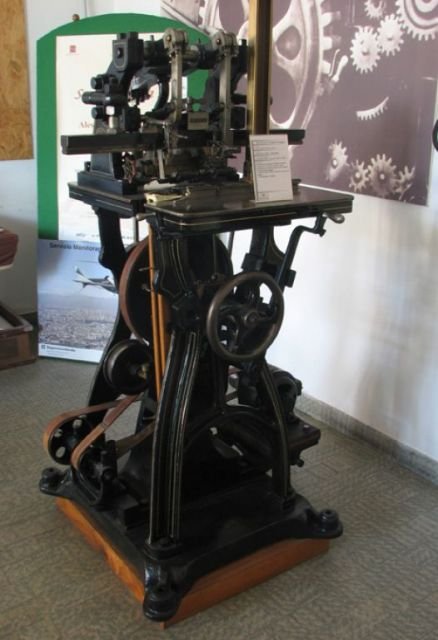ELECTRIC RAILWAY TICKET PRINTING PRESS

-
Item owner - FNM
-
Category - FNM Collection
-
Inventory - 0006
-
Author - G. Gobel Ganderberger
-
Dimensions - 178x129x137 cm
-
Dating - 1909-1937
The machine is primarily composed of the following parts: a rectangular base platform with four through holes at the top to allow it to be anchored to the ground. Four curved legs rising from the platform up to 2/3 of the machine’s height, where a steel shelf supports the body of the printing press. In the central part between the legs is an electric motor mounted on a metal pole, on the shaft of which is splined a smooth wheel from which, via a belt transmission, the movement begins, crossing a series of wheels and other belts to reach a shaft, on the lower part of which the printing stencil is assembled. Two rectangular columns of wood and brass, open at the front, feed in blank tickets to be printed, which, at the base, run along a horizontal slide, on which they advance, and then, after printing, the tickets that have passed under the printing stencil are collected. An ink reservoir supplies an inkpad that touches the stencil before it drops down to print the ticket.
The electric motor has the following features: Order no. 1404270; type AN 5/4; HP 0.5; 160 volts; 2.2 amperes; 1.2 rev/sec.
The machine prints, on Edmonson card pre-printed with the railway company’s data, the specifics of all the types of railway tickets in use (daily, weekly, monthly, etc., identifying the departure and arrival stations,
class and price).
The printer performs the following operations: preparing the stencil for the type of ticket to be printed and assembling it on the stencil holder; filling the wooden column upstream of the stencil with blank tickets to be printed; checking the level in the ink reservoir, changing the reservoir if the ticket is to be printed in a different colour. The printer then starts up the machine and manually checks that the printed ticket column is empty and the blank ticket column is full. The remaining operations are automatic and mechanically synchronised to ensure that a whole ticket is presented under the inked stencil and moves forward to make way for a new ticket. Start and stop levers are used to start and stop movement.
This type of machine, and other similar types, printed traditional Edmonson card railway tickets from the second half of the nineteenth century until the early 1990s: a type of ticket used not only by Ferrovie Nord Milano ever since the company was established in 1879, but also by Italy’s national railways and other concession railway operators. It had always been a characteristic element of rail transportation, to the extent that when it ceased to be used, tickets produced by the machine became collectors’ items, much in demand even outside Italy. The advent of new technologies in printing machines permitting ticket customisation directly and immediately right in the issuing station overcame the machine’s principal handicap: the need to pre-print vast quantities of tickets for delivery to each station, taking into account all the variables (ordinary one way and return tickets, discounted, weekly, monthly, first and second class tickets, different destinations...). This required railway companies such as Ferrovie Nord to operate their own printing presses, with significant storage, registration and accounting costs. Moreover, the size and thickness of card tickets were not suitable for advance sale of tickets to be cancelled (validated) at the time of use in machines designed for the purpose.
The machine on exhibit was used from 1942 until 1990. The first prototype machine had been built in 1853, and was modified during the final years of the war to produce cartridge cases. Ferrovie Nord’s Historical Archive indicates that discussions began with Goebel Georg of Darmstadt in 1909 for the purchase of ticket printing machines through its Italian representative Niebeling Max of Milan. Parts of the machine including direct current electric motors were supplied by AEG (Allgemeine Elektricitats-Gesellshaft of Berlin), which performed maintenance on the printing machines. The motor of the machine in the Museum was made by Ercole Marelli, and was evidently assembled later.